
Home
Preamble
Index
Areas
Map
References
Me
Drakkar
Saunterings: Walking in North-West England
Saunterings is a set of reflections based upon walks around the counties of Cumbria, Lancashire and
North Yorkshire in North-West England
(as defined in the Preamble).
Here is a list of all Saunterings so far.
If you'd like to give a comment, correction or update (all are very welcome) or to
be notified by email when a new item is posted - please send an email to johnselfdrakkar@gmail.com.
167. Yealand Woods, Leighton Hall and the Pheasants
I set out from the snow leopards aiming to enjoy the autumn colours of various Yealand Woods,
with Warton Crag to provide a final flourish. To the south was Hale Moss, a nature reserve of
the Cumbria Wildlife Trust. The map shows a flat area crossed by numerous straight blue lines
representing drainage ditches. Hale Moss is one of several ‘Moss’s in the region. It is therefore
no surprise to read that the region was once a lake. In fact, even with all the drainage ditches,
it is not far off one today, as most of the fields seemed waterlogged.

Hale Moss
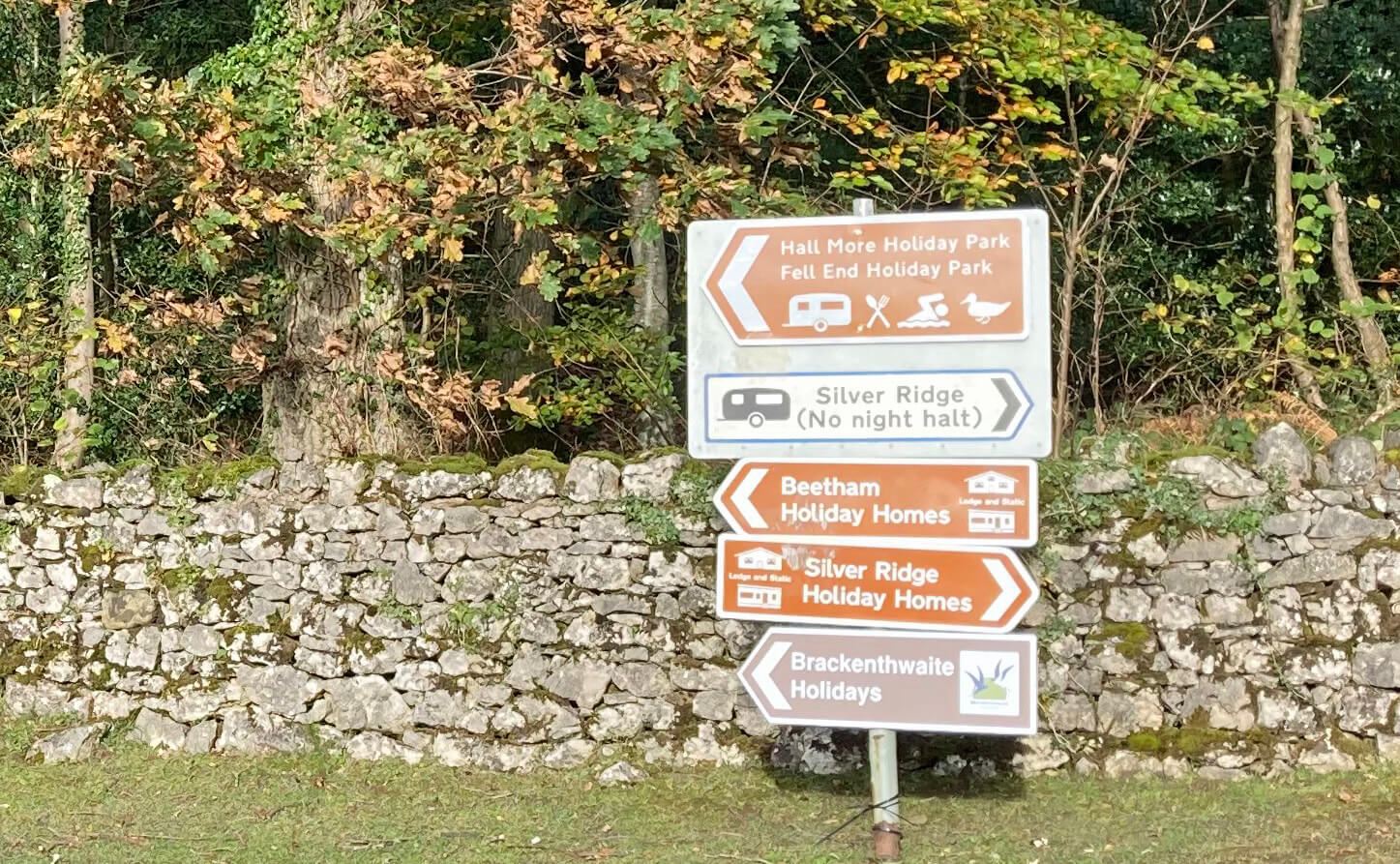 Oh, those snow leopards. They are in the Lakeland Wildlife Oasis by the A6. I didn’t seek them out on
this occasion although I did wonder if we will have plenty of snow this winter and they would
therefore feel more at home. I think not, on both counts.
Oh, those snow leopards. They are in the Lakeland Wildlife Oasis by the A6. I didn’t seek them out on
this occasion although I did wonder if we will have plenty of snow this winter and they would
therefore feel more at home. I think not, on both counts.
At the first road junction I was confronted by a sign directing me to six holiday parks but nowhere
else. I had no idea the region has been taken over by holiday parks. What do holiday-makers
do here? Do they use the parks as a base for commuting to the Lake District, where,
no doubt, holiday homes
are more expensive?
Right: Holiday parks galore.
I walked on along quiet lanes past limestone outcrops and various woodlands, including
Thrang Coppice, which I at least liked the name of.
The
woods were quiet and still although I did hear some nuthatches. I came to realise that the woods were past
their autumn best, with really only the hazel still holding onto its leaves, although they were a
rather insipid greeny-yellow. All the cheery reds and oranges were on the ground.
I came to the hamlet of Yealand Storrs, the first of several mentions of Yealand on the map.
According to British History Online
(1,
2),
“in 1066 there was only one manor of Yealand, and it no
doubt included Silverdale”. Over the centuries parts of the land passed through various hands, with a great
many names being referred to on the webpages mentioned. Among them I spotted a Henry de Redmayne
and a Robert de Conyers, who are presumably remembered in the names of the two nearby villages,
Yealand Redmayne and Yealand Conyers. I couldn’t, however, find a de Storrs to explain Yealand Storrs.
I walked on past Yealand Hall, a rather ordinary building for the eponymous hall of
such an historic region, and then south through Cringlebarrow Wood, another appealing name that I
have no explanation for. The wood is to the west of the village of Yealand Redmayne but provides no
view of it. Still, it was pleasant enough although I turned west halfway along to see Deepdale Pond.
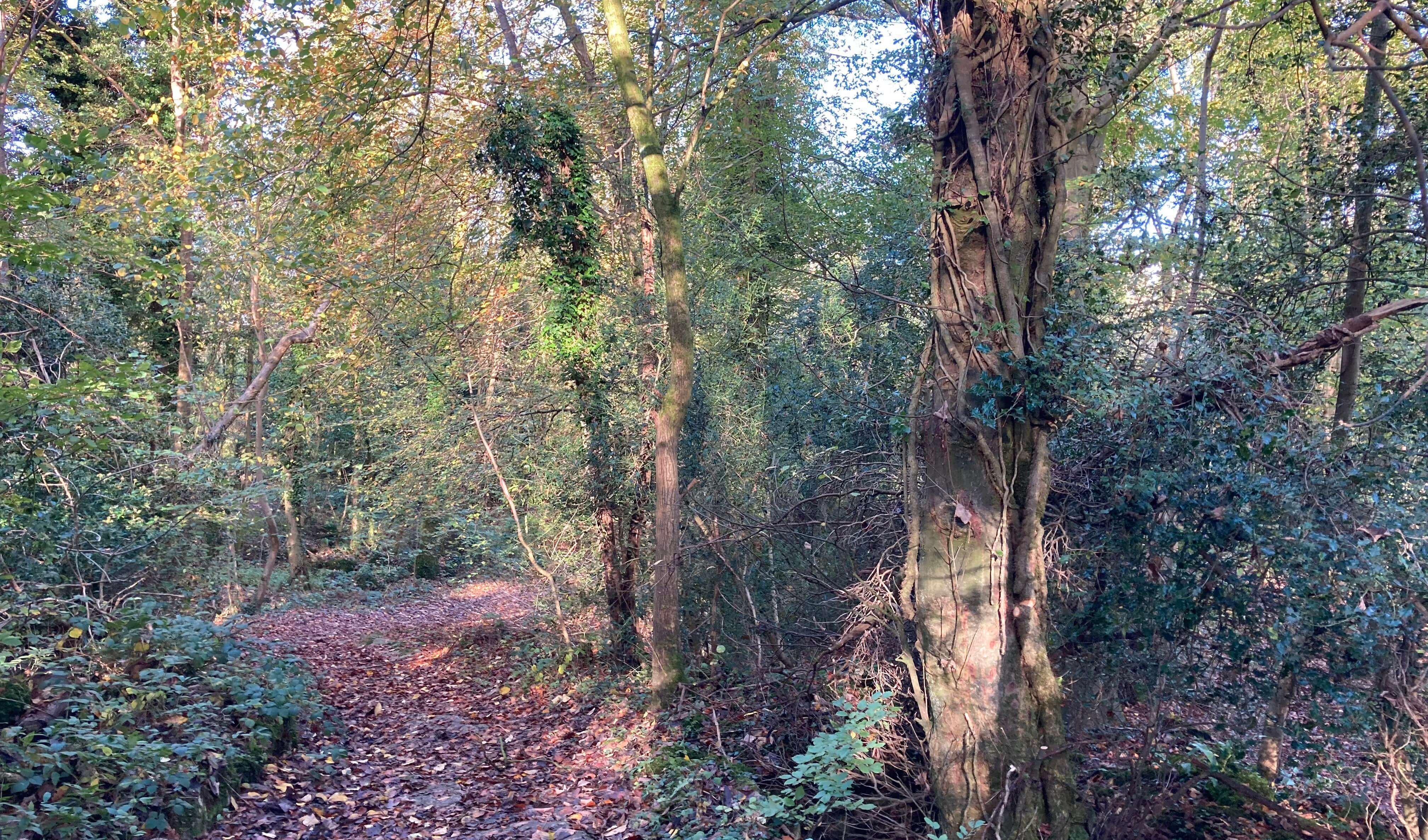
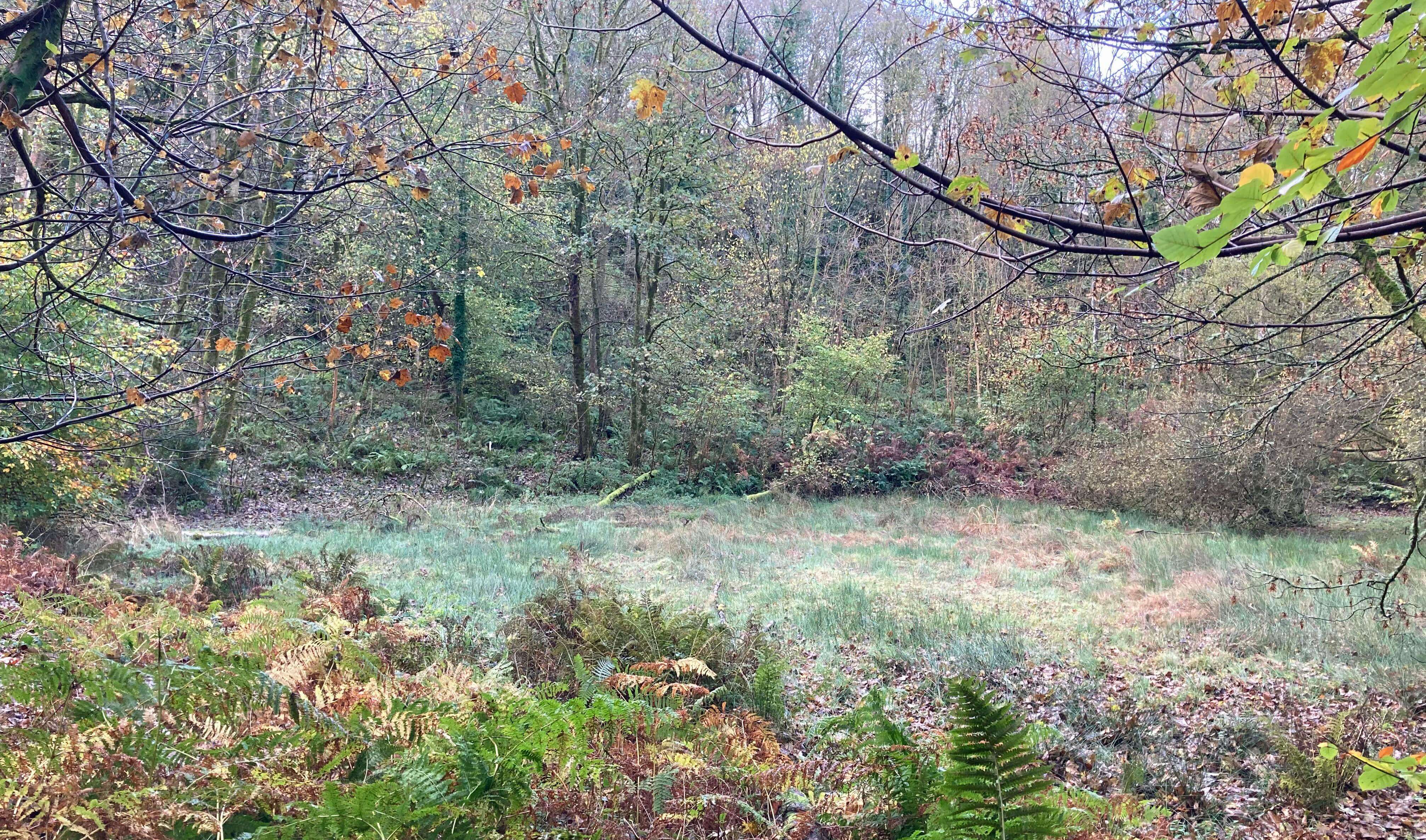
Left: Cringlebarrow Wood; Right:
Deepdale Pond.
This pond, as it is labelled on the map, lacks an essential feature of ponds, namely, water.
I understand
that a pond formed in a large sink-hole in the limestone but has now been covered with vegetation.
I didn’t step upon the ex-pond to see how solid it was.
(I am assuming that what I found was the pond. This
document
describes it as a "glistening jewel".)
The path, carefully enclosed within 'private' signs to make sure I didn't
wander where I shouldn't, continued to the estate of Leighton Hall. The present hall was built for George
Towneley of Towneley Hall near Burnley in 1759-1761 and was acquired in 1822 by the Gillow family,
of the world-renowned furniture makers Gillow & Co, which was founded in Lancaster by Robert Gillow (1704-1772).
The building was given its striking white façade of local limestone at that time.
The hall, with displays of Gillow furniture, is open to the public but only for three days a week (five in August)
for five months of the year.
The footpath to the
east provides a view of the hall and the estate, and across it to Morecambe Bay and the Lake District hills.

Leighton Hall
The path continues to Yealand Conyers but I didn’t go that far, instead cutting south towards Warton and
then taking the old track that climbs over the northern flank of Warton Crag to Crag Foot. I looked
for a way to leave the track to climb Warton Crag but didn’t find one for some distance, but from
there it was a direct path south-east to the top (169 metres). It provides a fine view over Morecambe
Bay to the hills of southern Cumbria – but they were in dark cloud which seemed to be coming my way,
so I set off hotfoot for Carnforth forthwith, which is easier done than said.
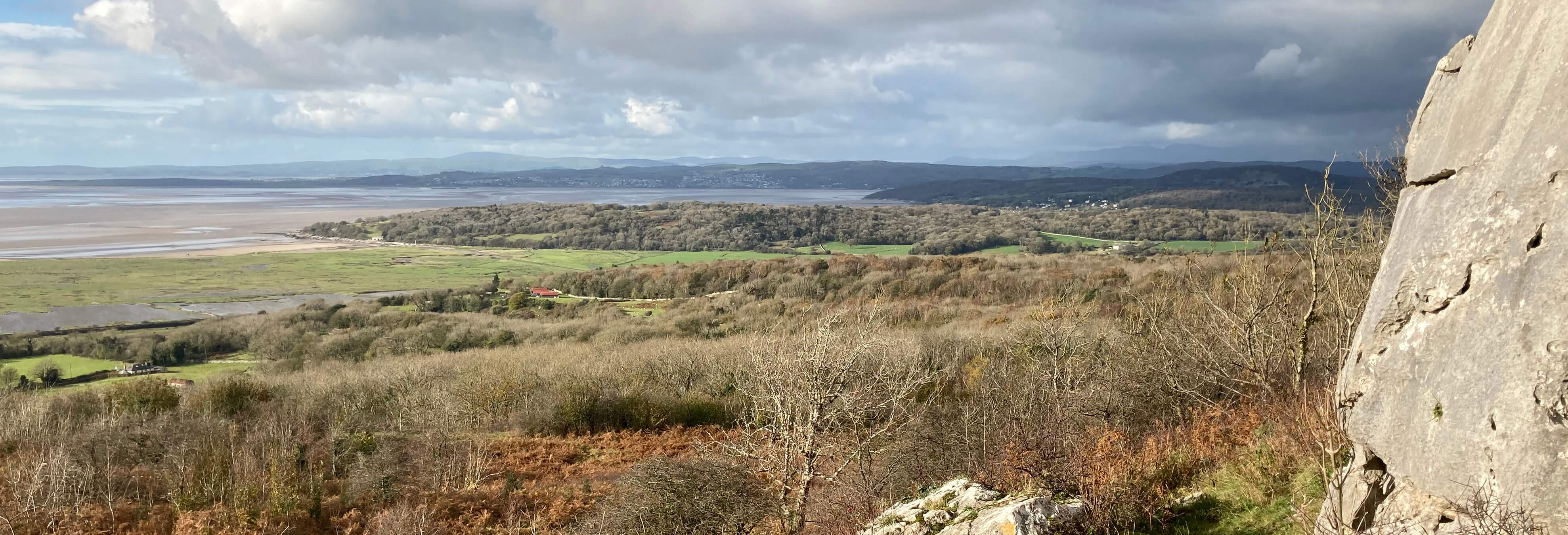
The view from Warton Crag
What do you think of Leighton Hall? Doesn’t it look grand? Well, I am rarely
content to give a brief
history of a mansion with an “oh, isn’t it marvellous!” photo. Here’s a couple of things that may
influence your opinion of Leighton Hall. The reputation of Gillow furniture was established in the
1730s when the company began to use mahogany imported from the West Indies, where it had been prepared for
export by slaves. Gillow & Co duly exported their esteemed products back to slave owners. Therefore,
Gillow & Co directly benefitted from the slave trade, as no doubt did many industrialists of the time.
Were the Gillows involved in the slave trade itself? It seems
(Elder and Stuart, 2021) that Robert
Gillow had a one-twelfth share of the ship Gambia, which made three slave journeys. So, yes, to a
minor extent. It is doubtful that Gillow himself paid much attention to it.
That’s all a long time ago. Is everything hunky-dory today? The present owners,
descendants of Gillow, stoutly bear the burden of maintaining the estate so
that they may continue to live there. Amongst the activities,
Leighton Hall offers pheasant-shooting
at £792 a day. On my walk the dominant sound was gunfire and the most common bird seen was pheasant.
In the UK at least 50,000,000 pheasants are bred every year to be shot.
A couple of
months ago a short film was released showing how Leighton Hall contributes to this number. If you are of a
sensitive disposition you may prefer not to watch
the film
and just accept my word that it shows pheasants
in an appalling condition. Actually, sensitive souls should watch the film. The pheasants need all
the outrage they can get. [*]
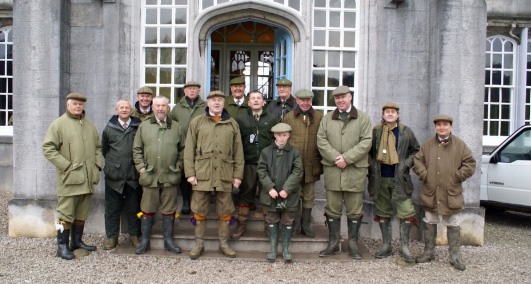
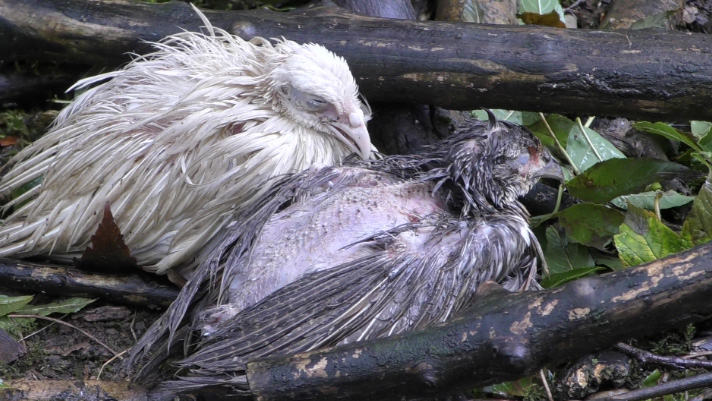 Left: On the portals of Leighton Hall a crack regiment ready for combat in the fields.
Left: On the portals of Leighton Hall a crack regiment ready for combat in the fields.
Right: The enemy, as seen in the fields around Leighton Hall.
What sort of society accepts that millions of people will struggle to feed
and heat themselves, while one family owns an estate of 450 acres and wealthy
individuals pay £792 a day to enjoy killing pheasants bred in squalor? Ours.
[*] Footnote added on December 4th 2022. The Lancaster Guardian of December 1st reported that
Lancashire Police attended Leighton Hall and said
"We conducted a joint visit with the RSPCA. No offences have been committed and no further
action taken." The original investigating team had already commented on their
website that
"We are informed that the RSPCA and police attended the site. However
by the time this visit was arranged, the gamekeeper had *somehow* been alerted and was able to
clear away the evidence. Despite the horrifying footage obtained, we believe no further action
is being taken." According to the Lancaster Guardian, Leighton Hall have said "they do
not wish to comment on the issue."
Date: November 4th 2022
Start: SD509778, Wildlife Centre on A6 (Map: OL7)
Route: (linear) S, SW, S past Hale More Farm, SW – Yealand Storrs – E past
Yealand Hall, S, SW – Leighton Hall Home Farm – E, S – road – SW, S, W on track, SE – Warton Crag – S,
E – Warton – W, S – Carnforth New Street bus stop
Distance: 8 miles; Ascent: 140 metres
Home
Preamble
Index
Areas
Map
References
Me
Drakkar
© John Self, Drakkar Press, 2018-

Top photo: The western Howgills from Dillicar;
Bottom photo: Blencathra from Great Mell Fell



 Oh, those snow leopards. They are in the Lakeland Wildlife Oasis by the A6. I didn’t seek them out on
this occasion although I did wonder if we will have plenty of snow this winter and they would
therefore feel more at home. I think not, on both counts.
Oh, those snow leopards. They are in the Lakeland Wildlife Oasis by the A6. I didn’t seek them out on
this occasion although I did wonder if we will have plenty of snow this winter and they would
therefore feel more at home. I think not, on both counts.





 Left: On the portals of Leighton Hall a crack regiment ready for combat in the fields.
Left: On the portals of Leighton Hall a crack regiment ready for combat in the fields.
